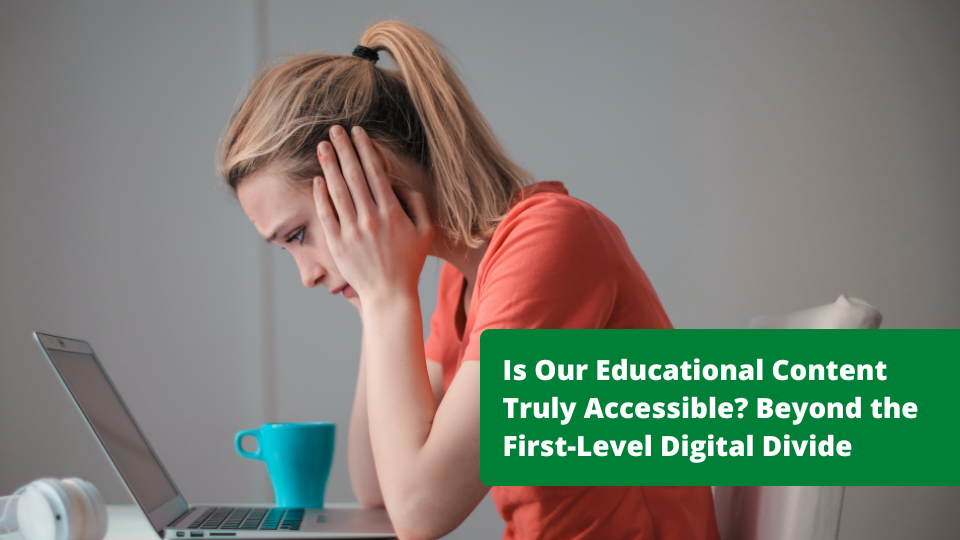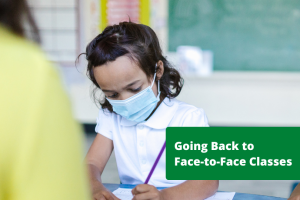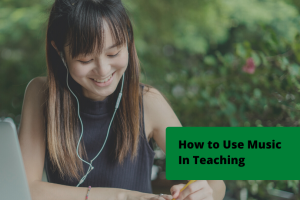Is Our Educational Content Truly Accessible? Beyond the First-Level Digital Divide
Is Our Educational Content Truly Accessible? Beyond the First-Level Digital Divide
By Jose Mari Almoradie Carpena
March 2023
Today’s students grew up with technologies we could only dream of in our youth. While we were struggling to maximize the space available in a 1.44 MB floppy disk, or at most a 256 MB flash drive, students these days can now upload their files on the cloud. While we had to use international landline services to contact our friends and relatives residing in other countries, students can now simply go on Zoom, Facebook, or Discord to message or even call others instantly for free. It is no surprise that many teachers and authors assume that students who grew up and continue to grow up with more advanced technologies (so-called “digital natives”, a coin termed by Prensky, 2001) already know how to use these technologies (e.g. Oblinger & Oblinger, 2005).
However, this is a myth and a dangerous assumption. First, there is a tendency to regard those individuals who belong to the millennial and subsequent generations as technologically proficient, without considering that some may not even have access or proper training and education in using Information and Communication Technologies (ICTs; Palfrey & Gasser, 2011). Indeed, several studies reveal a high level of variance and disparity between students in terms of ICT and technical skills (Hakkarainen et al., 2000; Umar et al., 2012; Siddiquah & Salim, 2017; Claro et al., 2012). These cleavages are labeled the second-level digital divide (the in/ability of a person to use ICTs in general, and reasons for utilization; Hargittai, 2002; Servon, 2002) and third-level digital divide (pertaining to the in/ability to utilize ICTs to improve one’s offline situation; Van Dijk & Hacker, 2003). This is troublesome, as ICT literacy is a vital skill to have to be able to properly function in this day and age
We usually assume that our students would be proficient in using technologies because they grew up with them. While that is usually true, we have to remember that the second-level and third-level digital divides exist. Yes, they might know how to use Facebook, TikTok, Instagram, and know how to use computer games, but they might not know how to use the software required for productive activities. Indeed, when we were conducting an action research to improve the e-learning skills of primary school students, I noticed that many of our students knew how to play games. They would open their browsers on the computers and go on Y8.com or other websites to play Flash games. Our initial surveys also revealed that they played many other games. However, the results also showed that they lacked the knowledge and skills to use productive software, like Microsoft PowerPoint, Word, Excel, and many were not able to use Google Search to find useful information.
Now how does this connect to our teaching practices
It is not uncommon for teachers to give out assignments and performance tasks which require students to use ICTs. For example, simply writing research papers requires students in this day and age to know how to use word processing software, such as Microsoft Word or LibreOffice Writer. Moreover, many students do not know how to use Google Scholar, or the other scholarly databases like EBSCO or ScienceDirect. This makes it difficult for students to find more reputable scholarly resources. If we expect them to work on data sets, they should be proficient in using spreadsheet software. They might also be expected to use some specialized software, such as SPSS or Statistica. Unfortunately, not all students know how to use these, making our activities or assessments less accessible. So what can we do to help our students?
Some suggestions
- Focus on learning outcomes. Instead of strictly requiring students to produce something that would arguably cost more to make, require more access to certain technologies and more technical skills to make, let students submit something similar. If your goal for the activity or assessment is to measure a non-technical learning outcome, then it wouldn’t make sense to restrict them. For example, if you wanted them to make a video commentary to measure their narration skills, then it would be best to allow those who do not know how to use video editing software to simply use a PowerPoint presentation instead. Always ask yourself: what are you measuring? Are you measuring technical skill (i.e., video editing) or are you measuring some other skill (i.e, narration, storytelling, etc.)?
- Look for free alternatives. Some of our students do not have access to certain technologies due to the simple fact that they lack the funds to purchase or subscribe to them. This was actually a big problem experienced by many students during the onset of the pandemic; many students relied on the computer labs which had the Adobe Creative Suite to edit their videos, but due to the lockdowns, they couldn’t access the labs anymore. This was similar to my problem when I was teaching an Arts Class. I didn’t want my students to buy an expensive video editing software just for my class, so I introduced them to ShotCut. It’s a free video editing software which has the basic function needed to create short films.
- Train students on how to use required technologies. Now this isn’t something that has to be solely done by the teacher. For example, a library unit can offer a short program or course to train students how to use databases and Google Scholar. A media unit can offer students training how to use video and audio editing software. Schools should remember that teachers are not alone in teaching students; a school, the surrounding community, and the support units should provide students with programs to enhance their learning as well.
With that, I hope our activities and lessons become more accessible in the future. If we don’t make them accessible for all our students, then we are just simply creating a gap within our classes. We would actually promote the digital divides in our classes, and put certain students at a more disadvantaged state.
References
Claro, M., Preiss, D. D., San Martín, E., Jara, I., Hinostroza, J. E., Valenzuela, S., … & Nussbaum, M. (2012). Assessment of 21st century ICT skills in Chile: Test design and results from high school level students. Computers & Education, 59(3), 1042-1053.
Hakkarainen, K., Ilomäki, L., Lipponen, L., Muukkonen, H., Rahikainen, M., Tuominen, T., … & Lehtinen, E. (2000). Students’ skills and practices of using ICT: Results of a national assessment in Finland. Computers & Education, 34(2), 103-117.
Hargittai, E. (2002). Second-level digital divide: Differences in people’s online skills. First Monday, 7(4). https://firstmonday.org/article/view/942/864
Khan, N., Sarwar, A., Chen, T. B., & Khan, S. (2022). Connecting digital literacy in higher education to the 21st century workforce. Knowledge Management & E-Learning, 14(1), 46–61.
Oblinger, D. & Oblinger, J. (2005). Is it age or IT: First steps towards understanding the net generation. In D. Oblinger & J. Oblinger (Eds.), Educating the net generation (pp. 2.1-2.20). EDUCAUSE.
Palfrey, J., & Gasser, U. (2011). Born digital: Understanding the first generation of digital natives. Basic Books.
Prensky, M. (2001). Digital natives, digital immigrants. On the Horizon, 9(5), 1–2.
Umar, I. N., & Jalil, N. A. (2012). ICT skills, practices and barriers of its use among secondary school students. Procedia-Social and Behavioral Sciences, 46, 5672-5676.
Servon, L. J. (2002). Bridging the digital divide: Technology, community, and public policy. Blackwell Publishers Ltd.
Siddiquah, A., & Salim, Z. (2017). The ICT facilities, skills, usage, and the problems faced by the students of higher education. EURASIA Journal of Mathematics, Science and Technology Education, 13(8), 4987-4994.
Van Dijk, J., & Hacker, K. (2003). The digital divide as a complex and dynamic phenomenon. The Information Society, 19(4), 315-326.
Tag:asist, digital divide, DLSU, education




